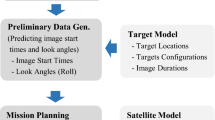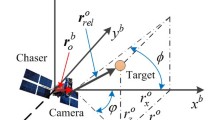Abstract
Large-scale and high-resolution perception is easy to achieve for the physical world, if satellite technology was used in Internet of Things (IoT) in the future. Remote sensing satellite is superior to original method for ground target detection and environmental perception, which could be completed through onboard perception sensors. In the process of detection and perception, satellite needs to frequently perform attitude maneuver in order to meet a variety of task requirements. We have to face with multi-object, multi-sensors constrained maneuver problem. Not only the kinematic and dynamics constraints should been taken into account, but the engineering bounded constraints need to be considered. Moreover, sensor pointing constraints should be elaborated and analyzed reasonably. It is increasingly important how to achieve attitude maneuver in these complex constraints safely and rapidly. Firstly, sensor pointing constraints are translated to quadratic form in order to simplify the representation and computation in the attitude quaternion space. Secondly, we propose an improved RRT planning algorithm for spacecraft, which is able to address a variety of sensor pointing constraints. This algorithm will be used as a global planner, in which the uniformly distributed nodes in the expansion space are randomly sampled and the expanded nodes are screened out based on the comparative evaluation function. Finally, simulation results validate the advantages of the proposed algorithm.










Similar content being viewed by others
References
Akyildiz, I., Melodia, T., & Chowdury, K. (2007). A survey on wireless multimedia sensor networks. Computer Networks, 51(4), 921–960.
Alagöz, F., Korçak, Ö., & Jamalipour, A. (2007). Exploring the routing strategies in next-generation satellite networks. IEEE Wireless Communications, 14(3), 79–88.
Ashton, K. (2009). That ‘Internet of Things’ thing. RFID Journal, 22(7), 97–114.
Atzori, L., Iera, A., & Morabito, G. (2010). The internet of things: a survey. Computer Networks, 54(15), 2787–2805.
Bi, Z., Xu, L., & Wang, C. (2014). Internet of things for enterprise systems of modern manufacturing. IEEE Transactions on Industrial Informatics, 10(2), 1537–1546.
Bisio, I., & Marchese, M. (2008). Efficient satellite-based sensor networks for information retrieval. IEEE Systems Journal, 2(4), 464–475.
Caubet A., & Biggs, J. (2013). Optimal attitude motion planner for large slew maneuvers using a shape-based method. AIAA Guidance, Navigation and Control Conference 2013.
Cheng, X., Cui, H., Cui, P., & Xu, R. (2010). Large angular autonomous attitude maneuver of deep spacecraft using pseudo-spectral method. 2010 3rd International Symposium on Systems and Control in Aeronautics and Astronautics (ISSCAA), IEEE, pp. 1510–1514.
Cheng, X., Cui, H., & Yu, M. (2012). Spacecraft attitude maneuver planning based on rapidly exploring random tree and sliding mode control. Proceedings of the 2012 International Conference on Electronics, Communications and Control. IEEE Computer Society, pp. 1519–1523.
Cui, P., Zhong, W., & Cui, H. (2007). Onboard spacecraft slew-planning by heuristic state-space search and optimization. International Conference on Mechatronics and Automation, pp. 2115–2119.
Fang, S., Xu, L., Pei, H., Liu, Y., et al. (2014). An integrated approach to snowmelt flood forecasting in water resource management. IEEE Transactions on Industrial Informatics, 10(1), 548–558.
Fang, S., Xu, L., Zhu, Y., et al. (2015). An integrated information system for snowmelt flood early-warning based on Internet of Things. Information Systems Frontiers, 17(2), 321–335.
Frazzoli, E., Dahleh, M., Feron, E., Kornfeld, R., & Kornfeld, R. (2001). A randomized attitude slew planning algorithm for autonomous spacecraft. AIAA Guidance, Navigation, and Control Conference, 2001.
Gubbi, J., Buyya, R., Marusic, S., & Palaniswami, M. (2013). Internet of Things (IoT): a vision, architectural elements, and future directions. Future Generation Computer Systems, 29(7), 1645–1660.
Hablani, H. (1999). Attitude commands avoiding bright objects and maintaining communication with ground station. Journal of Guidance, Control, and Dynamics, 22(6), 759–767.
Hughes, P. (2012). Spacecraft attitude dynamics. Mineola: Dover Publications.
Kawamoto, Y., Nishiyama, H., Kato, N., Yamamoto, S., Yoshimura, N., & Kadowaki, N. (2012) On real-time data gathering in next generation Satellite-Routed Sensor System (SRSS). 2012 International Conference on Wireless Communications and Signal Processing (WCSP 2012), Huangshan, China.
Kawamoto, Y., Nishiyama, H., Fadlullah, Z., & Kato, N. (2013). Effective data collection via Satellite-Routed Sensor System (SRSS) to realize global-scaled internet of things. IEEE Sensors Journal, 13(10), 3645–3654.
Kim, Y., & Mesbahi, M. (2004). Quadratically constrained attitude control via semidefinite programming. IEEE Transactions on Automatic Control, 49(5), 731–735.
Kjellberg, H., & Lightsey, E. (2013). Discretized constrained attitude pathfinding and control for satellites. Journal of Guidance, Control, and Dynamics, 36(5), 301–1309.
Kornfeld. R. (2003). On-board autonomous attitude maneuver planning for planetary spacecraft using genetic algorithms. AIAA Conference on Guidance, Navigation and Control, http://dx.doi.org/10.2514/6.2003-5784.
LaValle, S. (1998). Rapidly-exploring random trees: a new tool for path planning. Technical Report No.98-11, Computer Science Department, Iowa State University.
Li, S., Xu, L., & Zhao, S. (2015a). The Internet of Things: a survey. Information Systems Frontiers, 17(2), 243–259.
Li, X., Shen, J., Ma, W., & Zhang, W. (2015b). The effect of business ties and government ties on new IT venture growth: an empirical examination in China. Information Technology and Management. doi:10.1007/s10799-015-0233-5. online published.
Liu, Y., & Zhou, G. (2012). Key technologies and applications of Internet of Things. Proceedings of the Fifth International Conference on Intelligent Computation Technology and Automation (ICICTA).
McInnes, C. (1994). Large angle slew maneuvers with autonomous sun vector avoidance. Journal of Guidance, Control, and Dynamics, 17(4), 875–877.
McInnes, C. (1996) Non-linear control for large angle attitude slew maneuvers. Proceedings of the Third ESA Symposium on Spacecraft Guidance, Navigation, and Control, The Netherlands, pp. 543–548.
Tan, W., Chen, S., Li, J., Li, L., Wang, T., & Hu, X. (2014). A trust evaluation model for e-learning systems. Systems Research and Behavioral Science, 31(3), 353–365.
Whitmore, A., Agarwal, A., & Xu, L. (2015). The Internet of Things—a survey of topics and trends. Information Systems Frontiers, 17(2), 261–274.
Xu, L. (2011). Enterprise systems: state-of-the-art and future trends. IEEE Transactions on Industrial Informatics, 7(4), 630–640.
Xu, L., He, W., & Li, S. (2014). Internet of Things in industries: a survey. IEEE Transactions on Industrial Informatics, 10(4), 2233–2243.
Yan, H., Xu, L., Bi, Z., Pang, Z., Zhang, J., & Chen, Y. (2015). An emerging technology—wearable wireless sensor networks with applications in human health condition monitoring. Journal of Management Analytics, 2(2), 121–137.
Yin, Y., Xu, E., Li, L., Fan, Y., & Bi, Z. (2016) The Internet of things in healthcare: an overview. Journal of Industrial Information Integration 1(1).
Acknowledgments
This work was supported in part by the National Basic Research Program of China (973 Program) 2012CB720000, the National Natural Science Foundation of China (60803051), the Research Fund for the Doctoral Program of Higher Education of China (20111101110001) and the Civil Aerospace Research Project of China ‘Key Research on Autonomous Management and Control for Deep Space Exploration’.
Author information
Authors and Affiliations
Corresponding author
Rights and permissions
About this article
Cite this article
Xu, R., Wu, C., Zhu, S. et al. A rapid maneuver path planning method with complex sensor pointing constraints in the attitude space. Inf Syst Front 19, 945–953 (2017). https://doi.org/10.1007/s10796-016-9642-1
Published:
Issue Date:
DOI: https://doi.org/10.1007/s10796-016-9642-1




